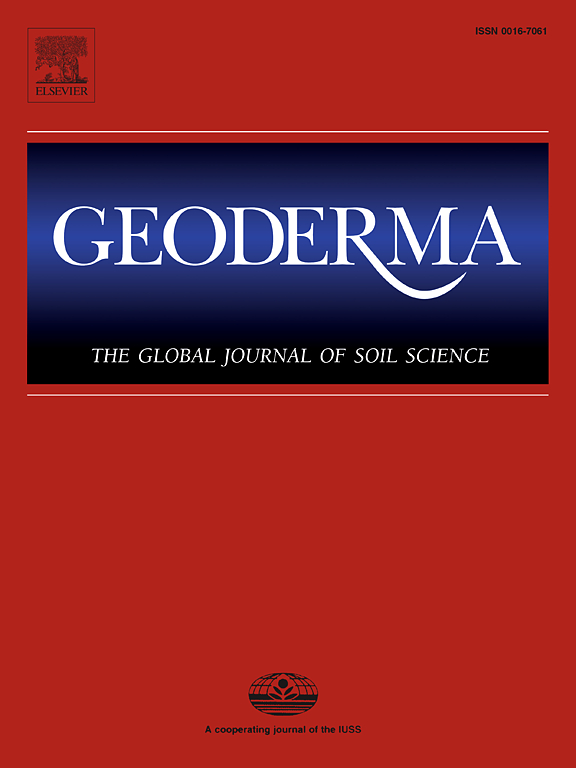Synergistic effects of microbial networks, glomalin-related soil protein, and humic substances jointly enhance the stability of soil aggregates: Evidence from converting pure Pinus massoniana plantations into uneven-aged mixed forests
IF 5.6
1区 农林科学
Q1 SOIL SCIENCE
引用次数: 0
Abstract
The stability of soil aggregates (SSA) serves as a sensitive indicator of soil fertility and plays a crucial role in determining resistance to erosion. However, the synergistic mechanisms of microorganisms, glomalin-related soil protein (GRSP), and humic substances (HS) by which SSA is altered through the conversion of Punus massoniana monoculture plantations into mixed broadleaf-conifer plantations remain unclear. We applied three different soil aggregate analysis methods, combined with high-throughput sequencing regions, to examine the impact of plantation diversification on SSA and microbial community structure. Specifically, we investigated a mixed plantation (MP) composed of two uneven-aged tree species (P. massoniana and Castanopsis hystrix) and a multiple-species mixed plantation (MMP) composed of several uneven-aged tree species (P. massoniana, Castanopsis hystrix, Michelia hedyosperma, Erythrophleum fordii, and Quercus griffithii). These were compared to a pure plantation (PP) of P. massoniana as the control. We also analyzed HS components and GRSP contents. Our results showed that the mean weight diameter (MWD) index and the proportion of soil macroaggregates (>0.25 mm) were significantly higher, while the new aggregate stability index (AS) was significantly lower in MP and MMP than in PP. Chao1 index values for bacteria (0–10 and 10–20 cm soil layers) and fungi (0–10 cm soil layer) were significantly higher in the MMP than in MP and PP. Moreover, the MP and MMP had greater HS component and GRSP levels than the PP plantations. The relative abundance of Chloroflexi, Gemmatimonadota, Ascomycota, and Kickxellomycota primary affected the particle size distribution of aggregates. PLS-PM revealed that higher litterfall mass (LF) and fine root biomass (FR) in mixed broadleaf-conifer plantations enhanced microbial diversity and network complexity via soil C and N accumulation, which directly stimulates GRSP secretion and HS formation, thereby enhancing SSA. Therefore, the introduction of broadleaf species into pure P. massoniana plantations is an effective strategy for preventing land degradation by preserving the complexity of belowground communities. Taken as a whole, this study provides new insights into the intricate interplay of plant–microbe-soil that will contribute to developing plantation management strategies to enhance stability of soil structure.

微生物网络、球囊素相关土壤蛋白和腐殖质的协同作用共同增强了土壤团聚体的稳定性:来自马尾松纯人工林向不均匀树龄混交林转化的证据
土壤团聚体稳定性是土壤肥力的敏感指标,对土壤抗侵蚀能力起着至关重要的作用。然而,微生物、glomalin-related soil protein (GRSP)和腐殖质(humic substances, HS)的协同作用机制尚不清楚,通过马马松单一人工林向阔叶针叶林混合人工林的转化,SSA发生了改变。采用3种不同的土壤团聚体分析方法,结合高通量测序区域,研究了人工林多样化对土壤SSA和微生物群落结构的影响。具体来说,我们研究了一个由两种年龄不等的树种(马尾松和桃栗)组成的混合人工林(MP)和一个由几种年龄不等的树种(马尾松、桃栗、含苞含苞、forred phleum fordii和Quercus griffithii)组成的多树种混合人工林(MMP)。以马尾松纯人工林(PP)为对照进行比较。分析了HS组分和GRSP含量。我们的研究结果表明,平均重量直径的比例(随钻测量)指数和土壤macroaggregates(在0.25毫米)明显较高,而新的聚合稳定指数()在国会议员显著降低,MMP页。Chao1索引值为细菌(清廉和10 - 20厘米土壤层)和真菌(清廉cm土层)明显高于MMP的议员和PP。此外,议员和MMP HS组件和GRSP水平大于人民党种植园。绿菌门、双胞菌门、子囊菌门和Kickxellomycota的相对丰度主要影响团聚体的粒径分布。PLS-PM结果表明,阔叶针叶混交林中较高的凋落物质量(LF)和细根生物量(FR)通过土壤C和N积累增强了微生物多样性和网络复杂性,直接刺激了GRSP的分泌和HS的形成,从而增强了SSA。因此,在马尾松纯人工林中引入阔叶植物是通过保持地下群落的复杂性来防止土地退化的有效策略。本研究为植物-微生物-土壤的复杂相互作用提供了新的见解,有助于制定人工林管理策略以提高土壤结构的稳定性。
本文章由计算机程序翻译,如有差异,请以英文原文为准。
求助全文
约1分钟内获得全文
求助全文
来源期刊

Geoderma
农林科学-土壤科学
CiteScore
11.80
自引率
6.60%
发文量
597
审稿时长
58 days
期刊介绍:
Geoderma - the global journal of soil science - welcomes authors, readers and soil research from all parts of the world, encourages worldwide soil studies, and embraces all aspects of soil science and its associated pedagogy. The journal particularly welcomes interdisciplinary work focusing on dynamic soil processes and functions across space and time.
 求助内容:
求助内容: 应助结果提醒方式:
应助结果提醒方式:


